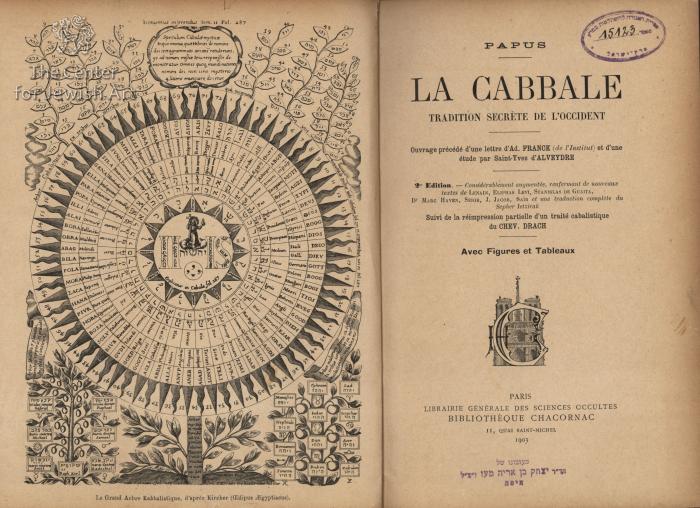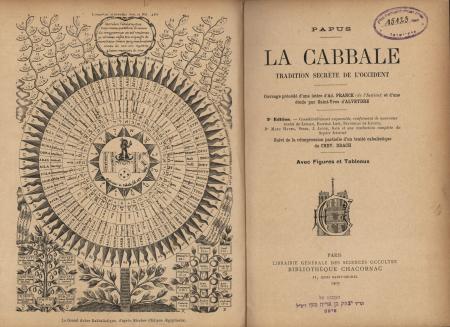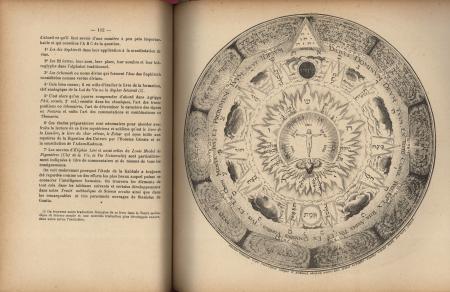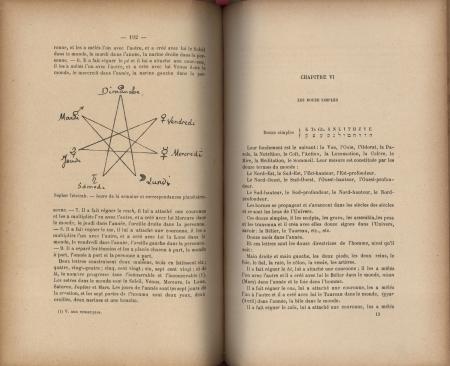Obj. ID: 40618
Jewish printed books La Cabbale by Papus, Paris, 1903

This text was prepared by William Gross:
Gerard Encausse was born at Corunna (La Coruña) in Spain on July 13, 1865, of a Spanish mother and a French father, Louis Encausse, a chemist. His family moved to Paris when he was four years old, and he received his education there.
As a young man, Encausse spent a great deal of time at the Bibliothèque Nationale studying the Kabbalah, occult tarot, magic and alchemy, and the writings of Eliphas Lévi. He joined the French Theosophical Society shortly after it was founded by Madame Blavatsky in 1884 - 1885, but he resigned soon after joining because he disliked the Society's emphasis on Eastern occultism.Career
In 1888, he co-founded his own group, the Kabbalistic Order of the Rose-Croix. That same year, he and his friend Lucien Chamuel founded the Librarie du Merveilleux and its monthly revue L'Initiation, which remained in publication until 1914.
Encausse was also a member of the Hermetic Brotherhood of Light and the Hermetic Order of the Golden Dawn temple in Paris, as well as Memphis-Misraim and probably other esoteric or paramasonic organizations, as well as being an author of several occult books. Outside of his paramasonic and Martinist activities he was also a spiritual student of the French spiritualist healer, Anthelme Nizier Philippe, "Maître Philippe de Lyon".
Despite his heavy involvement in occultism and occultist groups, Encausse managed to find time to pursue more conventional academic studies at the University of Paris. He received his Doctor of Medicine degree in 1894 upon submitting a dissertation on Philosophical Anatomy. He opened a clinic in the rue Rodin which was quite successful.
Encausse visited Russia three times, in 1901, 1905, and 1906, serving Tsar Nicholas II and Tsarina Alexandra both as physician and occult consultant. In October 1905, he allegedly conjured up the spirit of Alexander III, the Tsar Nicholas's father, who prophesied that the Tsar would meet his downfall at the hands of revolutionaries. Encausse's followers allege that he informed the Tsar that he would be able to magically avert Alexander's prophesy so long as Encausse was alive; Nicholas kept his hold on the throne of Russia until 141 days after Papus's death.
Although Encausse seems to have served the Tsar and Tsarina in what was essentially a shamanic capacity, he was later curiously concerned about their heavy reliance on occultism to assist them in deciding questions of government. During their later correspondence, he warned them a number of times against the influence of Rasputin.
Encausse's early readings in tarot and the lore of the Kabbalah in translation was inspired by the occult writings of Eliphas Lévi, whose translation of the "Nuctemeron of Apollonius of Tyana" printed as a supplement to Dogme et Rituel de la Haute Magie (1855), provided Encausse with his nom de plume: "Papus" means "physician."





